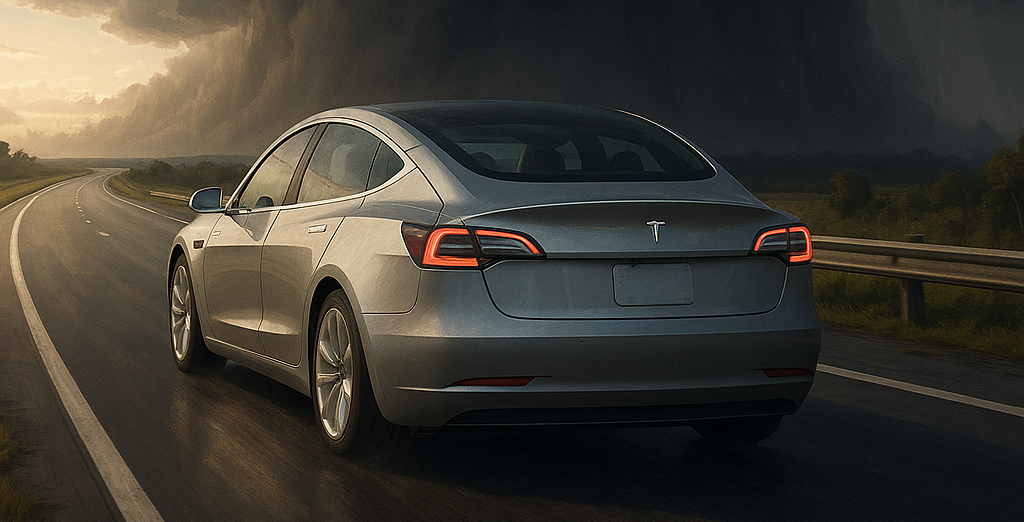In 2024, Tesla achieved over 657,000 vehicle sales in China. This marks a year-on-year growth of approximately 8.8% and setting a new record. According to data from China EV DataTracker, the Model Y became the best-selling car model in China in 2024, with a total of 480,309 units sold. Encouraged by this strong performance, the market generally expects Tesla’s sales to continue rising in 2025. Analysts surveyed by FactSet project that Tesla’s global sales will increase moderately by 16% year-on-year, reaching 2.07 million vehicles. Tesla CEO Elon Musk went even further in October 2024, stating that he expects sales to grow by 20% to 30% in 2025. He expects a significant portion of that growth to come from China, the world’s largest electric vehicle market.
Download our China luxury market report

Triumph in China, deterioration in international markets?
Since entering the Chinese market in 2014, Tesla has actively explored its potential by offering high-performance electric vehicles. Tesla cars are equipped with innovative technology and futuristic design, positioning itself as the “Apple of the automobile industry.” In addition, with a “USD 0 marketing budget”, cross-promotion with SpaceX, and the personal influence of Elon Musk, Tesla has successfully built a brand image in China that is closely associated with innovation and advanced technology.
The positive image Tesla has cultivated in China over the past decade has provided a solid foundation for its business performance.

Sales and growth rate of Tesla in China from 2021 to 2024
In 2024, Tesla’s global vehicle deliveries, which serve as a key indicator of sales, declined by 1.15% to 1.79 million units, marking the first annual drop since 2011. According to estimates from GlobalData, Tesla’s battery electric vehicle sales fell by 4.6% in North America and 10% in Europe. This makes China the only major market where the company recorded sales growth in 2024.
How Tesla saved its 2024 sales in China
Nevertheless, this does not mean Tesla faced no challenges in China during 2024. On the contrary, data from Gasgoo indicates that Tesla only recorded positive year-on-year growth in January and May during the first half of the year. While the sales dip early in the year could be attributed to the Chinese New Year holiday, the declines in March and June—both traditionally strong delivery months at the end of the quarter—suggest that Tesla had begun to hit a bottleneck in the Chinese market.
It wasn’t until July 1, 2024, when Tesla launched a five-year interest-free financing program, that sales started to recover. As Gasgoo noted, the “five-year interest-free offer was the key reason Tesla managed to achieve positive growth in China in 2024.”
Tesla in China: No more consumers’ “top choice”
Various surveys indicate that Tesla’s appeal among global consumers is gradually weakening. According to the South China Morning Post, citing a UBS survey of 10,500 respondents, only 18% of global car buyers named Tesla as their top choice in 2024—down from 22% in 2023. In the United States, the share of optimistic buyers declined from 38% to 29%, while in Europe, the proportion of consumers with a favorable view of Tesla dropped from 20% in 2023 to 15%.
China, Tesla’s largest consumer market, is no exception. The same report found that only 14% of Chinese consumers considered Tesla their preferred electric vehicle brand in 2024. This shows a significant decline from the peak of 30% in 2020. UBS further noted that although “Chinese consumers do prefer Tesla over other foreign brands,” domestic companies like BYD and Xiaomi have surged ahead by offering “strong product portfolios,” “technological innovation,” and “pricing strategies that better align with market expectations.”
What leads to Tesla’s sales challenge?
Fading product strength
For a long time, Chinese consumers have been drawn to Tesla’s strong product appeal. This was marked by its advanced electric vehicle technology, innovative autonomous driving features, and powerful brand image. However, with the rise of domestic EV brands in China, Tesla’s product strength no longer appears as compelling as it once was.
According to data from the China Passenger Car Association (CPCA), Tesla sold 163,338 vehicles at retail in the Chinese market from January to April 2025, representing a year-on-year decline of 0.31%. Data compiled by CnEVPost shows that Tesla’s market share in China’s battery electric vehicle (BEV) segment during the same period dropped to 7.96%, down from 11.44% a year earlier.
How local brands are outmanoeuvring Tesla?
A significant portion of consumers have shifted toward local NEV brands, particularly BYD and Xiaomi. These local manufacturers’ vehicles are often more competitive than Tesla’s in terms of features and pricing. For example, Xiaomi’s first and currently only model, the SU7, is positioned similarly to Tesla’s Model 3. It offers a version with City NOA (Navigate on Autopilot) for around RMB 200,000 (USD 27,760), and has been well-received since its launch. In contrast, Tesla’s Full Self-Driving (FSD) remains expensive in China and is available in limited quantities.
Another key competitor, BYD, has built an extensive product lineup. It has around 40 models available across its Dynasty and Ocean series. By comparison, Tesla offers only two mainstream models in China: the Model 3 and Model Y.

For Tesla in China, the bigger challenges are yet to come. In July 2025, Xiaomi is set to launch the Yu7—an SUV that founder Lei Jun has personally compared to the Model Y. Not only does the Yu7 closely match the Model Y in terms of size and specifications. It also surpasses Tesla’s updated Model Y in several key areas, including charging platform compatibility, battery capacity, and driving range. This will undoubtedly pose an even greater challenge to Tesla’s growth in the Chinese market.
Elon Musk’s public image: A double-edged sword
Beyond the challenges posed to Tesla’s product competitiveness, Elon Musk’s public image may also have a negative impact on the company’s sales in China. In the past, Musk earned public trust through his active presence on social media, engagement with social issues, and high-profile entrepreneurial successes such as the founding of SpaceX. This credibility extended to Tesla and its electric vehicles, which were seen as cutting-edge and trustworthy. However, as his public image becomes more controversial, it may begin to affect the brands he leads.
Such effects have already been observed in overseas markets, particularly in Europe. According to a recent survey conducted by T-Online with over 100,000 German respondents, as many as 94% said they would never consider purchasing a Tesla vehicle. It was largely due to dissatisfaction with Musk’s alleged interference in German elections and his support for the far-right Alternative für Germany (AfD) party. Only 3% indicated they would consider buying a Tesla.
Musk’s political visibility has also drawn attention in China. At the end of January 2025, during a speech in Washington, Musk made a gesture that many interpreted as resembling a Nazi salute. This immediately sparked widespread controversy on Chinese social media. While this has not yet caused the kind of reputational damage to Tesla in China that has happened in Europe, it is foreseeable that if Musk’s personal reputation continues to decline, more Chinese consumers may begin to think twice before purchasing a Tesla.

Tesla’s next move
Lower price, broader reach
As competition in the Chinese market intensifies, Tesla is under growing pressure and must make new strategic adjustments. One of the company’s recent initiatives could help support its sales in China: a new, lower-priced vehicle. During Tesla’s Q1 2025 earnings call, Lars Moravy, Tesla’s Vice President of Vehicle Engineering, stated that the company plans to launch a new model in mid-2025. This vehicle will align with Tesla’s current design language but be more affordable for consumers.
The new budget-friendly electric vehicle, codenamed “Redwood,” is expected to be a compact crossover, with a starting price of around RMB 180,000 (USD 25,000). Compared to the RMB 250,000 (USD 35,000) price tag of the Model 3 and Model Y, this more affordable model could help Tesla tap into a broader segment of the market.
Tesla in China: More than just electric vehicles
On February 11, 2025, Tesla held a commissioning ceremony for its Shanghai Megafactory in Lingan. This marks the rollout of its first commercial-scale Megapack, a large electrochemical energy storage system. Compared to Tesla’s first Gigafactory, this new Megafactory—completed in just seven months—has received relatively less public attention.

However, it reflects Tesla’s growing focus on expanding its energy business. In the future, solar energy and storage products are expected to become new growth drivers for the company.
In fact, Tesla’s efforts in this space are already showing results. According to the company’s 2024 annual report released on January 30, 2025, Tesla’s energy storage deployments reached 31.353 GWh for the year. It is up 114% year-on-year, with a gross margin of 26.17%, which already outpaces that of its electric vehicle business.
How Tesla’s megafactory gives it a cost edge in China’s energy storage race
The launch of the Shanghai Megafactory provides Tesla with a strong foothold in China’s massive energy storage market. According to BloombergNEF, the Asia-Pacific region accounted for 56% of the global energy storage market last year, with demand from China leading the way. Moreover, producing energy storage systems in China brings significant cost advantages. Thanks to a skilled, cost-effective workforce and favorable government policies, Megapacks’ production cost from the Shanghai facility is expected to be substantially lower. This can further enhance Tesla’s product competitiveness and profitability.
China’s energy storage market is also highly competitive. Major players such as Sungrow, CATL, and CNESA actively expanding their presence. As such, Tesla’s energy business in China will undoubtedly serve as a new growth driver for the company. In turn, advancements in energy storage systems, particularly in battery management and thermal control technologies. These are expected to benefit Tesla’s electric vehicle business as well.
Besides, the factory will also significantly enhance Tesla’s synergy with Chinese battery manufacturers. The primary supplier of battery cells for Tesla’s Megapack systems in China is CATL (Contemporary Amperex Technology Co. Limited). Through collaboration with local manufacturers, Tesla is expected to substantially reduce the production cost of its Megapack units, enabling the company to better penetrate the domestic market. This cost advantage could also strengthen Tesla’s global competitiveness in the utility-scale energy storage sector.
Tesla in China: A tipping point or a dead end?
- As Tesla’s global electric vehicle market share declines, the importance of the Chinese market continues to rise.
- However, the company is losing its appeal among Chinese consumers and is no longer the top choice for many.
- Tesla now faces growing challenges from increasingly competitive local brands and sometimes controversial public image of Elon Musk.
- Beyond electric vehicles, Tesla is actively expanding its presence in China’s energy storage sector.





